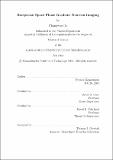Reciprocal space phase gradient neutron imaging
Author(s)
Do, Changwoo, 1978-
DownloadFull printable version (1.001Mb)
Other Contributors
Massachusetts Institute of Technology. Dept. of Physics.
Advisor
.
Terms of use
Metadata
Show full item recordAbstract
Perfect crystal real space imaging has limitations in its resolution imposed by position sensitive detectors. The disadvantage, its limited resolution, of a position-sensitive detector can be overcome by replacing the conventional detector with an area detector and moving to reciprocal space. Reciprocal space imaging is proposed in this thesis with the state-of-the-art neutron interferometry at National Institute of Standard and Technology. An aluminum wedge produces various phase gradients and a specially designed sample is introduced as a test subject. Superposition of the waves from the sample beam path and the gradient wedge beam path creates an interferogram that suggests an inhomogeneous phase distribution. The result shows the existence of spatially encoded phase gradients, even though imaging was unsuccessful. A next generation design of reciprocal space imaging is proposed in the conclusion.
Description
Thesis (S.M.)--Massachusetts Institute of Technology, Dept. of Physics, 2003. Includes bibliographical references (leaves 77-78). This electronic version was submitted by the student author. The certified thesis is available in the Institute Archives and Special Collections.
Date issued
2003Department
Massachusetts Institute of Technology. Department of PhysicsPublisher
Massachusetts Institute of Technology
Keywords
Physics.